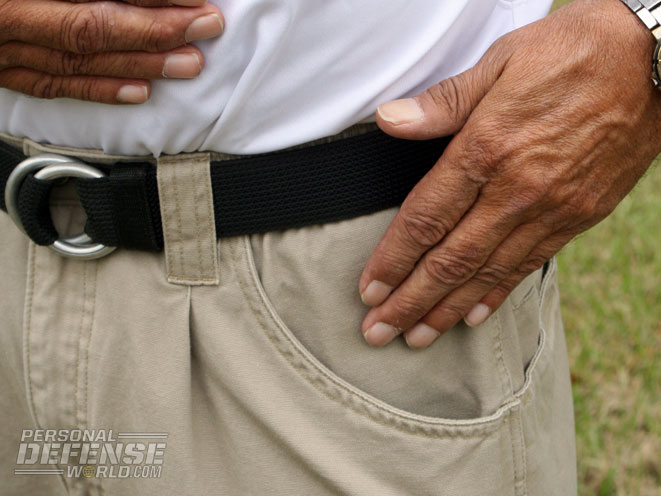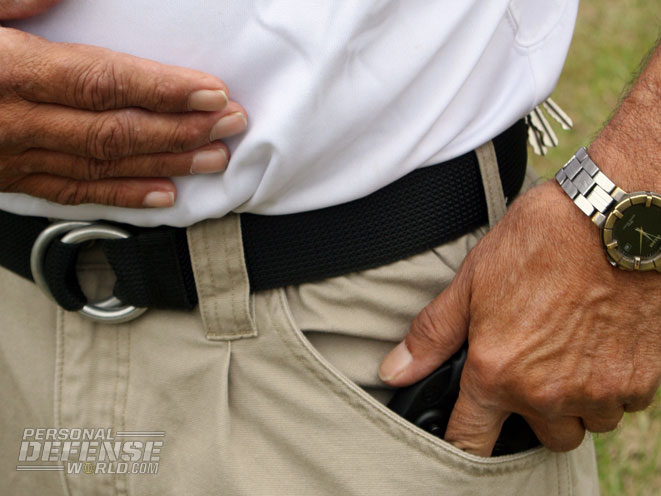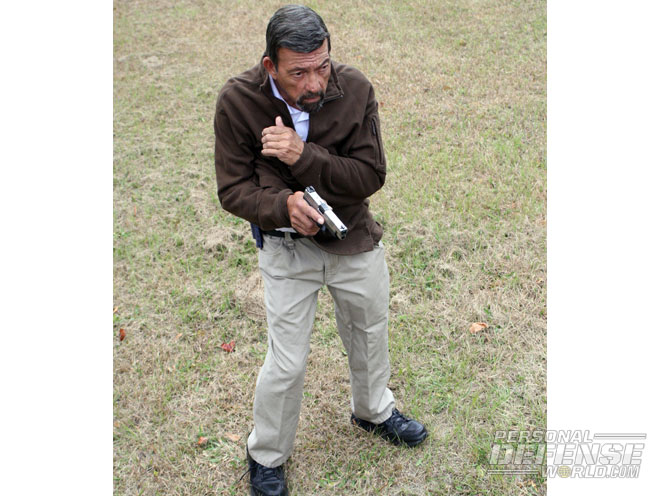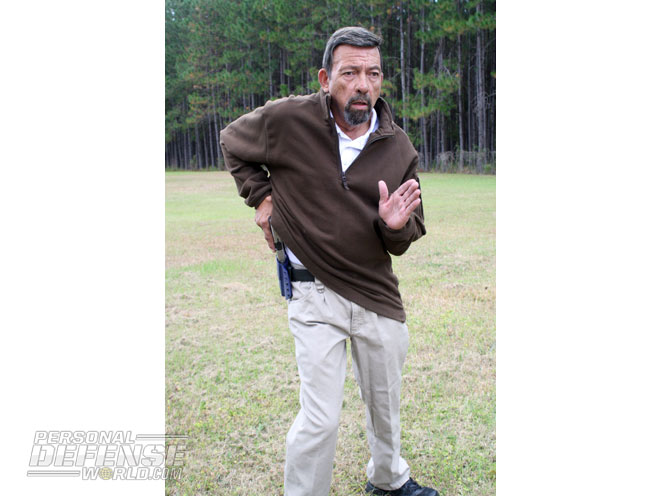You’ll occasionally hear a citizen pistol-packer say something like, “I don’t need quick draw skills—after all, I’m not a cop.” That is a very questionable theory. When a uniformed police officer has the slightest doubt and draws his or her gun, people know enough to get out of the way and don’t mistake him for a mass murderer or jihadist. When an unidentifiable citizen clears leather without obvious reason, folks start screaming and calling 9-1-1, and words like “brandishing” start being uttered. Thus, circumstances often constrain the law-abiding armed citizen from drawing until the danger is more apparent, which usually means the danger is greater. Therefore, often having to wait longer to reach for the gun, the armed citizen may actually need quick-draw skills more than the law enforcement officer.
Click below to learn Massad Ayoob’s five methods of concealed quick-draw!
Open-Front
Advertisement — Continue Reading Below
The most common carry location, particularly for a full-sized defensive handgun, seems to be on the strong-side hip. The technique of the draw will vary somewhat depending on the concealing garment.
Open-front garments, such as an unfastened jackets or concealment vests, offer the fastest access from concealed carry. There are many ways to clear the coat, but some are more efficient than others. Flipping the garment back with the hand or a twist of the hip can work, but there is a very short and finite window of access before the garment falls back over the gun, which can foul the draw. The “throw” also won’t work well if you’re seated, particularly with a seat belt on, or if you have your back to a wall in a fight. I teach clearing such “cover” by letting all four fingertips of the gun hand touch the midline of the abdomen and then, maintaining light contact, sweeping the hand back to the gun. The heel of the hand and the outer edge of the little finger hold the garment back as long as is necessary to grasp the pistol.
RELATED: 10 Steps to Choosing the Right Concealed Carry Pistol
Advertisement — Continue Reading Below
That grasp is best achieved by driving the gun hand down on the holstered pistol, the web of the hand making contact with the grip tang of the semi-automatic or the topmost edge of the “horn” at the back of the revolver’s frame. The trigger finger should be pointed straight, outside the holster. At this time, the shooter releases any safety strap or other retaining device that might be in place, and the other three fingers all firmly grasp the grip frame in a firing hold.
Now, pull the gun straight up and as soon as the muzzle clears, rock it forward toward the threat. We call it “rock and lock.” If you have a fast-closing attacker, this puts the muzzle in line to hit him somewhere if you have to fire before you can raise the gun.
Now thrust the gun straight toward the threat, getting the front sight up to eye level as soon as you can. If you’re hoping for a two-hand hold, as the gun hand goes to the sidearm you might want to bring the inside wrist of your support hand in to your solar plexus area, with the fingers pointed forward toward the threat. This allows the fastest possible access of support hand to firing hand, coming in safely, of course, from behind the gun muzzle.
Advertisement — Continue Reading Below
Closed-Front Garments, Two Hands
Closed-front garments, such as a draping T-shirt, polo or sweatshirt, require some additional techniques. Unlike the open-front garment, you’ll need one technique for a one-handed draw and a separate tactic for two-handed work.
RELATED: Concealed Carry Tips & Techniques for Dressing Around the Gun
Advertisement — Continue Reading Below
If both hands are free, use your support hand to grasp the hem of the garment on the side of the belt that is toward the gun, and jerk it upward as high as you can toward the shoulder of your gun arm. This will give you the maximum possible clearance for the draw. Pioneered by famed expert Ken Hackathorn, this technique became known as the “Hackathorn Rip.” The gun hand now proceeds straight down onto the grip frame of the holstered handgun, and you draw from there as in the open-front garment technique just described above, with one more difference: In case some of the lower part of the garment is still near the holster where it could snag the draw, drop your hip down and to the opposite side as you clear the gun from its scabbard. This has the effect of helping to pull the holster down and away from the pistol, guaranteeing a clean draw.
Closed-Front Garments, One Hand
If one hand is busy pushing a victim out of the way or fending off a very close threat, you’ll need a different technique. For one hand only, let the thumb of the gun hand track up your leg and catch the bottom edge of the closed-front garment, pulling it upward ahead of the hand. Be sure that you have a firm grasp on your sidearm with no garment material caught between your hand and gun before you “clear leather.” That drop of the hip down and to the side (to the left, if you’re carrying on right hip) is particularly important here, since you don’t have the other hand available to make sure the concealing garment is all the way up and clear of handgun and holster.
Advertisement — Continue Reading Below
Pocket Carry
To use the side pants pocket for successful carry and deployment, you will need at least four things: (1) A compact, streamlined handgun; (2) a good quality pocket holster; (3) deep pockets in pants that are not skin-tight; and (4) practice!
The pocket should be dedicated totally to the holstered gun, with no coins, keys or anything else there to get in the way. A good pocket holster will break up the outline and ensure good concealment, and keep the gun in a constant, accessible orientation. It must prove itself in practice by never leaving the pocket with the gun. There are many fine pocket holsters on the market; my own choice, after trying a great many, is the elegantly simple unit Bill Rogers designed for Safariland.
Advertisement — Continue Reading Below
RELATED: 87 Concealed Carry Holsters for Everyday Defense
Choice of gun? I’ve pocket-carried everything from the chunky .45 caliber Glock 30 to a tiny North American Arms mini-revolver there, but I keep going back to lightweight Smith & Wesson J-Frame hammerless or Ruger LCR snub-nose revolvers loaded with five rounds of Speer Gold Dot 135-grain +P .38 Special hollow-point ammo. Engineered by an ATK team led by the great Ernest Durham to give optimal performance from a short barrel, the lab and the street alike have proven this cartridge to deliver exactly that. The shape of the butt and “hammer area” offers the least snag potential of anything I’ve worked with out of the side pocket. On most higher-capacity, striker-fired pistols, the back of the slide has to be square-backed and overhang the back of the hand, which can snag on the upper edge of the pocket. We each have our own choices, but I’d rather have five rounds of .38 Special right now than 10 rounds of 9mm a second from now if I’m reacting to a fast-breaking emergency.
Pocket Draw
Advertisement — Continue Reading Below
To begin the draw, straighten your fingers, with your thumb pointing toward your fingertips. This creates the hand shape martial artists call a “spear hand” and allows the hand to “knife” through the opening of the pocket to get the quickest contact with the gun. As the fingertips enter, the trigger finger stays straight. Make sure it’s outside the pocket holster, between the holster and the pocket lining. Be sure the trigger finger is not pressing against the holster; if it is, it can pull the holster out with the gun! The other three fingers take their regular draw/fire grasp of the grip.
Thumb position is extremely important here. I’ve found it most efficient to keep the thumb pointed straight forward while the hand is still in the pocket. On my hammerless J-Frame, it will be at the top of the gun where the hammer would be. (If the gun does have a hammer spur, you want the thumb in exactly that same place: The thumb will act as a “human hammer shroud” to prevent the spur from catching on the pocket’s lining and stalling you draw.)
Extract the gun smoothly out of the pocket. Depending on the cut of your pants and pocket, you may have to tug the gun slightly to the rear to clear the edge of the pocket. As the gun comes free, “rock and lock” and thrust toward the target exactly as you would have done in the aforementioned hip holster draw. As soon as the gun is out of the pocket, you want the thumb to come down into firing position.
Advertisement — Continue Reading Below
RELATED: Concealed Quickdraw
Why is that thumb business so important? Try the following with an empty gun, or you can just use your bare hand. Curl the hand into a firing hold, or make a fist out of it, while inside your pocket. Now, jerk it out. You’ll probably find that the hand didn’t want to exit the pocket without extra effort. This is because a curled-down thumb, or even a thumb placed to the side of the gun, widens the whole hand, and there’s only so much space in the pocket opening for that hand to come out through. Now, try it again with the thumb up and forward, as if on top of the gun and pointing toward the muzzle. This greatly reduces the lateral profile of the hand and allows a much faster and smoother draw from the pocket, whether or not it is holding a gun.
Practice lots and lots with unloaded guns or dummy guns before you try any of these techniques with live ammunition. Good luck and stay safe!




















































